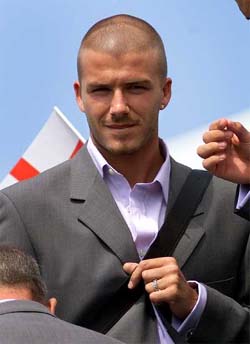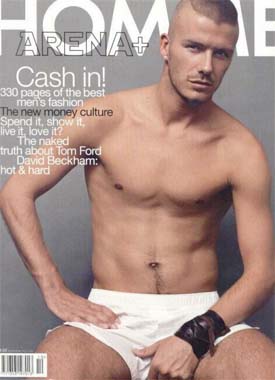
|
Jesse's Journal
Of course metrosexuality is not new, nor is "Becks's" reputation as being "the ultimate metrosexual" (to quote Australia's The Age). The word itself was coined by author Mark Simpson, who in 1994 wrote an article titled Metrosexuals: Male Vanity Steps Out of the Closet. Published in Britain's Independent (and reprinted in Simpson's anthology It's a Queer World: Deviant Adventures in Pop Culture), the essay defines a "Metrosexual man" as a "single young man with a high disposable income, living or working in the city (because that's where all the best shops are) . . . . In the eighties he was only to be found inside fashion magazines such as GQ, in television advertisements for Levi's jeans, or in gay bars. In the nineties, he's everywhere, and he's going shopping." But metrosexuality is more than just a fashion trend. As Simpson writes, "the metrosexual man contradicts the basic premise of traditional heterosexuality - that only women are looked at and only men do the looking. Metrosexual man might prefer women, he might prefer men, but when all's said and done nothing comes between him and his reflection." Eight years later, Simpson saw fit to (re)introduce metrosexuality (and David Beckham) to out-of-touch Americans, this time on the Web site Salon.com. Noting that Beckham famously posed for a British gay mag with no subsequent uproar, Simpson went on to remind us that: "Becks is almost as famous for wearing sarongs and pink nail polish and panties belonging to his wife, Victoria (aka Posh from the Spice Girls), having a different, tricky haircut every week and posing naked and oiled up on the cover of Esquire, as he is for his impressive ball skills. . . . Beckham is the biggest metrosexual in Britain because he loves being looked at and because so many men and women love to look at him: He's the future, but also a way of adapting other, less advanced specimens to that future. More to the point, he sucks corporate cock with no gag reflex. . . . The Beckham advertising phenomenon, however, goes beyond the usual cash-in, slightly wooden product endorsements of sporting stars. Becks gives the impression that he'd do it for nothing (except the attention); he's a sporting star who wants to be a model."
Beckham, Dr. Andrew Parker of Warwick University told The Age, helped break "masculine codes . . . [by] defying various manly expectations such as what clothes a man is allowed to wear." Thanks to this role model, many straight boys are willing to forego centuries of macho hangups in order to be "bent" like Beckham. Nor is Becks the only famous metrosexual. Other celebs in the metrosexual hall of fame include Brad Pitt - whom Simpson called a "smooth Calvin Klein model turned Hollywood pretty boy" - Australian swimmer Ian Thorpe - whom The Age described as one who "loves Armani, is seen just as often near a catwalk as competing in sport, confesses an adulation for Kylie Minogue, [and] even designs his own jewelry" - "Marky" Mark Wahlberg, Bill Clinton, George Clooney, Johnny Depp, Jude Law, Ewan McGregor and even the Amazing Spider-Man. All of these men, I should point out, are heterosexually inclined. A metrosexual, Simpson writes, "might be officially gay, straight or bisexual, but this is utterly immaterial because he has clearly taken himself as his own love object and pleasure as his sexual preference." Still, the best-known metrosexuals are hetero; or what Attitude magazine calls "strays" ("gay-acting" straight men). Indeed, the Word Spy (www.wordspy.com) defines a metrosexual as "A dandyish narcissist in love with not only himself, but also his urban lifestyle; a straight man who is in touch with his feminine side." Schuyler Brown, who helped Euro RSCG Worldwide conduct a study of American men later published as The Future of Men: USA, wrote that metrosexual men "are very secure in their sexuality. . . . They're comfortable getting a facial or a pedicure. It doesn't make them feel any less masculine or any less heterosexual."
When it comes to lifestyles, queer people rush in where heterosexuals fear to tread. We set the parameters for straight people, who may or may not then follow us into previously uncharted territory. In the words of author Judy Grahn, gay people "are closely watched to see what constitutes the limit of a thing - too far out, too much, too low, too bad, too outrageous, too soft, too dangerous, too rough, too cultured, too aggressive, too sexual." From restoring neighborhoods to piercing nipples, queer people lead and heteros follow; once the heteros think that it's safe to do so. So it took decades of fag leadership and influence in fashion, grooming, dining and design to convince straight boys that it was OK to become metrosexuals. Though metrosexuals are currently trendy, I doubt that they will take over a world dominated by NASCAR races and Spike TV. Only a small minority of straight men has followed Becks into his brave new world; and even many gay men are reluctant to become slaves to fashion. (Bears, though gay, are anti-metrosexuals.) And the rise of metrosexuality will not bring about the end of homophobia or heterosexism, not even in metrosexual men. Straight metrosexuals, after all, are still heterosexual, with all of their straight privileges. Beckham, for example, was able to marry his Posh Spice, which is something that gay couples can not do. Clothes and cosmetics, however fashionable, only go skin deep. If David Beckham and other metrosexual men really want to make an impression, they ought to have sex with other men. Now THAT would be radical.
|
|
 Metrosexual and soccer stud David Beckham
Metrosexual and soccer stud David Beckham  Beckham has attracted both men and women through his numerous cover photo appearances in international magazines
Beckham has attracted both men and women through his numerous cover photo appearances in international magazines  Jesse Monteagudo is the kind of gay man who could never make it on Queer Eye For The Straight Guy. Like-minded individuals may e-mail him at
Jesse Monteagudo is the kind of gay man who could never make it on Queer Eye For The Straight Guy. Like-minded individuals may e-mail him at